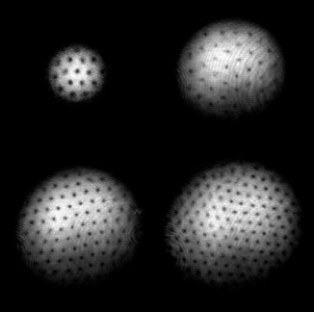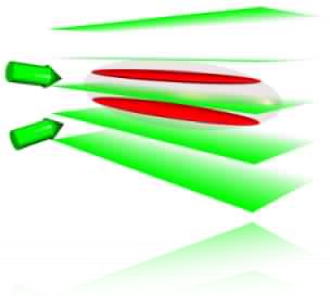Cold Atoms and Lieb-Liniger Model
“A heart of cold soft and cool collection of atoms”

Under unimaginably cold conditions, matter presents new types of physical behaviour and their properties turn out to be quite unusual. As the thermal motions of atoms and molecules become smaller and smaller, the elusive quantum world — usually hidden at higher temperatures — starts playing its role and enters overbearing the scene: quantum phenomena take place on a macroscopic scale.
Superfluidity of liquid helium, first observed in the 1930s, is one of the earliest and most tangible examples. This phenomenon occurs at just 2 K but modern laser-cooling technology can do much better than that, attaining indeed much lower temperatures. When we approach the absolute zero, first
atoms go into their lowest energy state; their motion and position are limited only by Heisenberg’s uncertainty relation. Second, atomic gases of bosonic statistic form a new quantum state of matter, known as Bose-Einstein condensate. This happens below a critical temperature, which depends on the density of the gas, the mass of its atoms and the geometrical parameters of the magnetic trap. The cloud of atoms of the condensate pays no heed to everyday physical rules, as the individual atomic identities are lost and the all particles blur into a coherent quantum entity.

The main difference between atomic gas condensates and superfluid helium lies in the strength of the particle interactions, which are much weaker in the former system. Moreover, thanks to optical lattices and resonance tuning of the atomic energy levels, it is nowadays possible to achieve many geometrical and dynamical set-ups, in particular one-dimensional geometry. All these cold-atom systems are enormously versatile, therefore making an interdisciplinary impact in fields such as non-linear dynamics, strongly
correlated systems, high-energy theoretical physics and quantum information processing.
So far, my main interest in the field has been mainly focused on quantum quenches, which can be cleanly studied in such systems, and on the properties of the one-dimensional Bose gases.
So far, my main interest in the field has been mainly focused on quantum quenches, which can be cleanly studied in such systems, and on the properties of the one-dimensional Bose gases.
In a series of papers, written in collaboration with M. Kormos and A. Trombettoni, we showed that the repulsive Lieb--Liniger model can be obtained as the non-relativistic limit of the Sinh--Gordon model: all physical quantities of the latter model ($S$-matrix, Lagrangian and operators) can be put in correspondence with those of the former. Thanks to this mapping, we were able to use the thermal formalism of LeClair-Mussardo and the exact form factors of the Sinh--Gordon model for setting up a compact and general formalism for computing the expectation values of the Lieb--Liniger model both at zero and finite temperature.
Relevant Publications
• M. Kormos, G. Mussardo, A. Trombettoni, Expectation Values in the Lieb-Liniger Bose Gas, Phys. Rev. Lett. 103, 210404 (2009), http://lanl.arxiv.org/abs/0909.1336
• Article selected for the December 2009 issue of “Virtual Journal of Atomic Quantum Fluids” published by the American Physical Society (Eds. W. Ketterle, M. Greiter, P. Zoller).
• M. Kormos, G. Mussardo, A. Trombettoni, 1D Lieb-Liniger Bose Gas as Non-relativistic Limit of the Sh-Gordon Model, http://lanl.arxiv.org/abs/0912.3502., Phys. Rev. A 81, 043606 (2010)
• M. Kormos, G. Mussardo, B. Pozsgay, Bethe Ansatz Matrix Elements as Non-relativistic limit of Form Factors of Quantum Field Theories, arXiv:0912.3502 [cond-mat.stat-mech]
• E. Fersino, B.A. Malomed, G. Mussardo, A. Trombettoni, Ultracold Bosons with 3-Body Attractive Interactions in an Optical Lattice, arXiv:0902.473,
• Special issue of European Physical Journal B on the conference "Theory of Quantum Gases and Quantum Coherence" held in Grenoble, 2008
• E. Fersino, G. Mussardo, A. Trombettoni, One-Dimensional Bose Gases with N-Body Attractive Interactions, Phys. Rev. A 77, 053608 (2008). http://lanl.arxiv.org/abs/0801.3688
• F.Mancarella, G. Mussardo, A. Trombettoni, Energy-pressure relation for low-dimensional gases, Nucl. Phys. B 887, (2014), 216.
• M. Kormos, G. Mussardo, A. Trombettoni, Local correlations in Super Tonks-Girardeau Gas , Phys. Rev. A 83, 013617 (2011)
• L. Lepori, G. Mussardo, A. Trombettoni, (3+1) Massive Dirac Fermions with Ultracold Atoms in Frustrated Cubic Optical Lattices, Europhys. Lett. 92 (2010), 50003.
Main References
• L.P. Pitaesvkii, S. Stringari, Bose-Einstein Condensation, Oxford University Press 2003.
• T. Giamarchi, Quantum Physics in One Dimension, Oxford University Press 2004
• V. E. Korepin, N.M. Bogoliubov, A.G. Izergin, Quantum Inverse Scattering Method and Correlation Functions, Cambridge University Press 1993
• E.H. Lieb and W. Liniger, Exact Analysis of an Interacting Bose Gas I: The General Solution and the Ground State, Phys. Rev. 130. 1605 (1963).
• E.H. Lieb, Exact Analysis of an Interacting Bose Gas II: The Excitation Spectrum, Phys. Rev. 130. 1616(1963).
• C.N. Yang, C.P. Yang, Thermodynamics of one-dimensional system of bosons with repulsive delta-function interaction, Journ. Math. Phys. 10, 1. 1115 (1969).
• F.D.M. Haldane, Effective Harmonic-Fluid Approach to Low-Energy Properties of One-Dimensional Quantum Fluids, Phys. Rev. Lett. 47, 1840 (1981)
• V.A. Yurovsky, M. Olshanii, D.S. Weiss,
Collisions, Correlations and Integrability in Atom Wave-guides, Ad. At. Modl. Opt. Phys. 55, 61 (2008).
• A. Koubek, G. Mussardo, On the Operator Content of the Sinh-Gordon Model, Phys. Lett. B 311, 193 (1993).
• A. LeClair, G. Mussardo, Finite Temperature Correlation Functions in Integrable QFT, Nucl. Phys. B 552, 624 (1999).
